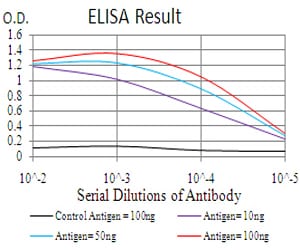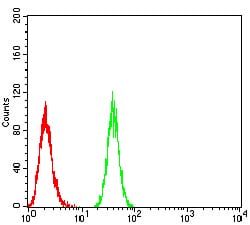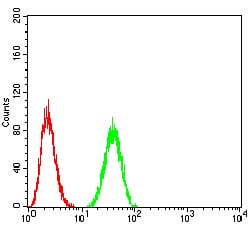


| WB | 咨询技术 | Human,Mouse,Rat |
| IF | 咨询技术 | Human,Mouse,Rat |
| IHC | 1/25-1/100 | Human,Mouse,Rat |
| ICC | 技术咨询 | Human,Mouse,Rat |
| FCM | 咨询技术 | Human,Mouse,Rat |
| Elisa | 1/5000-1/10000 | Human,Mouse,Rat |
| Aliases | BDA2; BMP2A |
| Entrez GeneID | 650 |
| clone | 9E10D6 |
| WB Predicted band size | 44.7kDa |
| Host/Isotype | Mouse IgG1 |
| Antibody Type | Primary antibody |
| Storage | Store at 4°C short term. Aliquot and store at -20°C long term. Avoid freeze/thaw cycles. |
| Species Reactivity | Human |
| Immunogen | Purified recombinant fragment of human BMP2 (AA: 283-396) expressed in E. Coli. |
| Formulation | Purified antibody in PBS with 0.05% sodium azide |
+ +
以下是3篇涉及GNLY(Granulysin)抗体的参考文献及其简要摘要:
---
1. **文献名称**:*Granulysin, a novel antimicrobial peptide in cytotoxic granules of human lymphocytes*
**作者**:Pena SV et al.
**摘要**:首次发现并鉴定了GNLY作为细胞毒性T细胞和NK细胞颗粒中的抗菌蛋白,研究利用特异性抗体证实其在杀伤病原体和肿瘤细胞中的作用。
---
2. **文献名称**:*Granulysin activates antigen-presenting cells through TLR4 and acts as an immune alarmin*
**作者**:Tewary P et al.
**摘要**:通过抗体验证发现GNLY可作为免疫警报素,结合TLR4激活树突状细胞,研究采用抗GNLY抗体阻断实验证明其在先天免疫中的信号传导功能。
---
3. **文献名称**:*Granulysin in human serum as a marker of cell-mediated immunity*
**作者**:Ogawa K et al.
**摘要**:开发了一种基于GNLY抗体的ELISA检测方法,用于定量血清中的GNLY水平,揭示其在结核病等感染性疾病中的诊断潜力。
---
如果需要更多文献或具体研究方向的扩展,建议通过PubMed或Google Scholar以“Granulysin antibody”为关键词进一步检索。
**Background of GNLY Antibody**
Granulysin (GNLY), a cytolytic protein expressed by cytotoxic T lymphocytes (CTLs) and natural killer (NK) cells, plays a critical role in innate and adaptive immunity. Discovered in the late 1990s, GNLY belongs to the saposin-like protein family and exhibits antimicrobial, antitumor, and proinflammatory activities. Structurally, it contains a pore-forming domain that disrupts microbial and tumor cell membranes.
GNLY is stored in cytotoxic granules alongside perforin and granzymes, released upon immune cell activation to directly kill pathogens or cancer cells. It demonstrates broad-spectrum antimicrobial activity against bacteria, fungi, and parasites, particularly in combating intracellular pathogens like *Mycobacterium tuberculosis*. Beyond direct cytotoxicity, GNLY modulates immune responses by promoting dendritic cell maturation and enhancing cytokine release (e.g., IFN-γ), bridging innate and adaptive immunity.
GNLY antibodies are essential tools for detecting its expression in tissues or serum, aiding research into its role in infections, cancer immunosurveillance, and inflammatory diseases. Dysregulated GNLY levels are linked to autoimmune disorders, transplant rejection, and impaired pathogen clearance, highlighting its therapeutic potential. Studies also explore GNLY-based therapies, such as recombinant proteins or vaccines, to augment immune responses. Its dual function as a cytotoxic effector and immune modulator makes GNLY a key focus in immunopathology and therapeutic development.
×